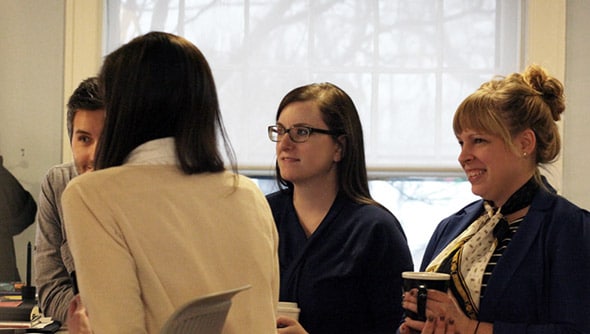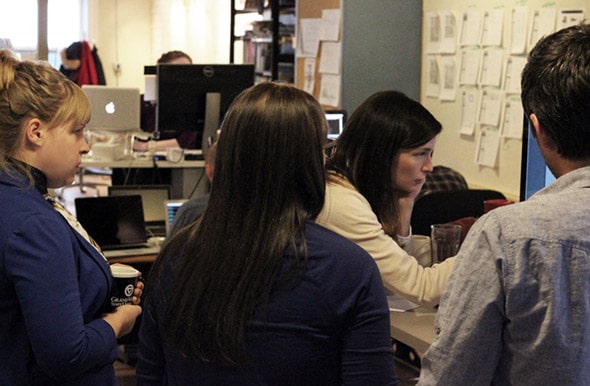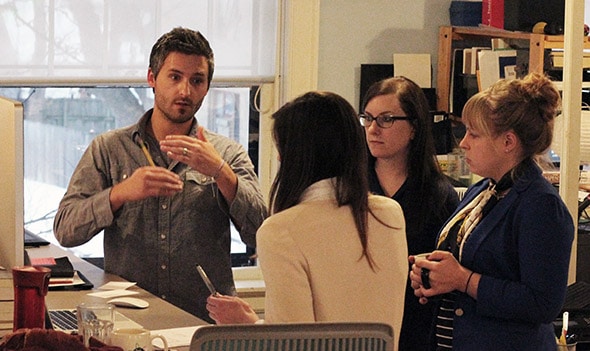Article summary

Art school tends to get a bad rap — something about living in a cardboard box and having the worst projected salary after graduation. Thankfully that’s not all true, and many of the skills I learned while getting my B.F.A. now apply daily to my role designing software.
The basic design skills I learned (grid structures, color theory, typography, concept development) were valuable, but the most important thing I learned was critique.
Critique:
transitive verb: to examine critically
noun: a detailed analysis and assessment of something, esp. a literary, philosophical, or political theory.
At Atomic Object, we hold formal critiques with the design team each week, in addition to ad hoc team critiques that happen much more frequently. For the weekly design critique, designers present their work to the rest of the design team. I find this really helpful because it allows the design team to work together even though each designer may be on a different client project. This makes the design critique an important weekly ritual in our evolving design practice.
Surviving a Critique
Critique needs to be seen as a two-way street to be successful. If the presenter is ill-prepared or if the audience isn’t providing good feedback, the critique can easily turn south. Many people aren’t comfortable exposing their work to a group. With practice, you can overcome this fear, allowing critique to become one of the most rewarding parts of the creative process.

On Giving Productive Critique
- Start positive. Beginning with a positive comment can help set a good vibe for the meeting. The creator has likely spent time on the work, and even if they know it’s not perfect, starting negative may create a stressful feedback loop. Some language you might consider using could be “Yes, and…”, “What if?”, or “X feels really strong, I wish that y…”.
- It shouldn’t be personal. It’s important to remember the core purpose of critique is to make the work better and ensure the creator has considered as many options as possible. Critique is used to move things forward in an iterative fashion and give the team an opportunity to work as a whole. Keeping comments focused around achieving user, business, and project goals is best.
- Use objective reason & ask questions. The presenter is in search of a safe place to discuss concepts and get feedback. Those giving feedback appear more credible and thoughtful by asking questions. Comments that refer to research or a specific area for improvement give the presenter a clear place to go back later and improve. “I just think it could be better” is poor feedback for the creator because it’s difficult to specifically address. This sort of language can devalue creative work into a solely subjective craft.

On Receiving Critique Constructively
- Share often. The more you share your learnings and the work, the more your team will get comfortable with critique and the challenges around a project. As the person presenting, the more you practice the more at ease you will be with laying your work on the line.
- Describe the context. Set the stage for a good discussion by describing the challenges you are facing. Keep this concise; you will want to avoid skewing feedback by giving too much explanation. You can save more detail for later as questions arise.
- Be prepared. Present work in the most appropriate format for the critique. Should it be printed? Viewed on screen? Taped to the wall? A Combination of both? Having this figured out beforehand respects the time of your team mates.
- Guide your audience. Critique can trigger powerful emotional responses to work. It takes some digging to find out what tangible elements contribute to the feeling. If you are hearing subjective or vague responses, help guide your team by asking, “Why?” This can help dig through those gut reactions and give your teammate an opportunity to articulate their thoughts in a clearer way.
- Write things down. The team mates providing critique are giving time and energy to help you deliver better results. It shows respect to write down the points they make. There’s nothing worse than the same points coming up again at the next critique because you forgot about them. Don’t expect yourself to remember each point of detail; a few hours later you could forget.
- Restate and define. At some point in the conversation, it will probably make sense to restate the main areas of discussion to the group to recap and wrap up the critique. Prioritize as a group the most complex challenges and ideas to prescribe a working solution.
- Let it go. It’s easy for a critique to become heated, and that’s okay as long as the team can rebound and resolve the conflict. If things do become heated, do your best to let things go afterwards — or set up a separate meeting to talk things through and resolve the issue.
Most people I know in creative, maker roles are passionate about what they do. Giving and receiving critique can take many, many years to get good at, but critique is one of the key steps in creating excellent work. It’s worth it.

Great guidelines, Julia. I see connections with what I called “positive engagement” in a Great Not Big blog post: http://greatnotbig.com/2013/06/transparency-requires-positive-engagement/. Same risks, same potential upside, totally different context.